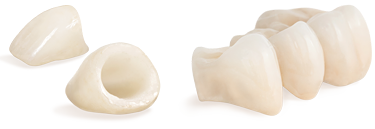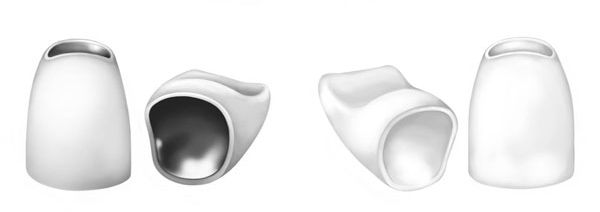AESTHETIC CROWNS
Cosmetic crowns in Puerto de la Cruz, Tenerife
AESTHETIC CROWNS
A dental crown or dental cap is an individual restoration of a tooth with both functional and aesthetic utility.
Thanks to this type of prosthesis it is possible to protect a damaged or broken tooth. As with all fixed prostheses, the teeth are handcrafted, customising the shape, colour and the anatomical and aesthetic needs of the patient’s mouth.
At Artedental, your dentist and your prosthetist will work hand in hand, using the highest quality materials on the market and specific machinery to guarantee maximum precision of fit, key to the future prognosis and durability of your dental rehabilitation.

In which cases are aesthetic dental crowns used?
1. To reinforce a weakened tooth.
When a tooth has suffered a trauma, which has led to a breakage or if it has had a large filling or has had a root canal, it is advisable to reinforce it with a crown in most cases.
2. As part of a dental bridge.
Crowns can also replace a complete tooth when they are part of a dental bridge. The crowns at the ends will be “caps” and will function as abutments to support the bridge.
3. Crowns on implants.
In the case of placing a dental implant to replace a missing tooth, the crown is placed on the implant and it will not be necessary to grind the adjacent teeth, as in the case of a bridge. In almost all cases, the placement of an implant with a crown is the best solution to replace a missing tooth.
4. Crowns for aesthetic reasons.
Crowns can also be used to correct aesthetic problems of the teeth, fundamentally in the smile area; colour, shape, alignment…
How is a dental crown fitted?
- The tooth on which the crown will be placed is prepared and filed.
- Impressions are then taken with silicone or a dental scanner to obtain a mould which is sent to the prosthetic laboratory.
- A temporary cover is placed.
- Once the crown has been manufactured in the dental laboratory, its fit is tested on the patient.
- If everything is correct, the crown is definitively cemented and the occlusion is adjusted as well as the contact points with the adjacent teeth so that the bite is optimal.



What types of dental crowns are there?
- Aesthetic zirconium crowns: These are the most aesthetic as the zirconium (or zirconium) has a degree of transparency very similar to that of the natural tooth. They are very resistant and aesthetic, which is why they are currently the most commonly used.
- Metal dental crowns: They can be made of different metal alloys such as chrome-cobalt or gold-palladium. They are the most durable but undoubtedly the least aesthetic. Nowadays they are rarely used, and when they are used it is only in molars, in non-visible parts.
- Ceramic dental crown: The only disadvantage of this type of crown is that they are not very resistant. Their main advantage is that they adapt very well to the natural colour of the tooth. For this reason they are used to replace the most visible teeth and the ones that are chewed the least. They are perfect for people who are allergic to metal. And in recent times, many advances are being made to extend their life.
- Metal ceramic (porcelain) crown: This is a combination of the two previous ones. It consists of a metal cap or coping covered with porcelain. It is a long-lasting and more aesthetic solution than the metal one, but it has the disadvantage that over time the grey bond between the metal and the tooth tends to become noticeable as the gums recede.
Frequently asked questions:
If dental crowns are taken care of they can last more than 10 years without problems, but we must remember that the crown is supported by a tooth that can also suffer from decay and by a gum that can also become diseased. It is very important to take as much care of our hygiene as if the crown were a natural tooth. We must also avoid using our teeth as a tool so as not to damage either our natural teeth or the caps or crowns.
Yes, it is possible to replace an old crown with a new, more aesthetic one.
No, fitting the veneer is not painful. Any process that may be painful or uncomfortable for the patient is performed under local anaesthesia. For patients with phobia or fear, Artedental also offers the option of conscious sedation.
